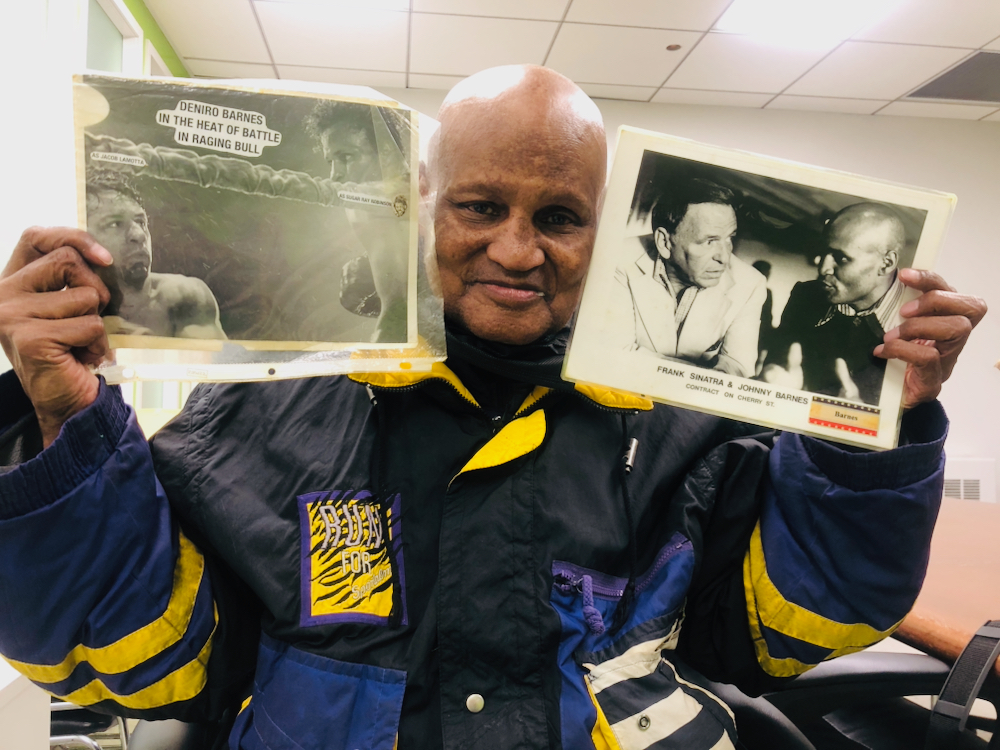
Johnny Barnes is 80 now, but he remembers boxing with Robert DeNiro as if it were yesterday.
De Niro was playing middleweight champion Jake LaMotta. Barnes was playing Hall of Famer Sugar Ray Robinson. The movie was Martin Scorsese’s 1980 classic Raging Bull—still considered one of the greatest films of all time.
The fighting had to look violent, it had to look painful, and above all, it had to look real.
“Scorsese is a genius,” said Barnes. “We started out this far from each other”—indicating a distance of several feet. “When I threw a punch DeNiro would react and when he threw a punch I would react. Every day we moved a foot closer until we were right on each other, and then we worked that way for 7 weeks.” It was a precise choreography; they couldn’t react before the punches “landed,” but they couldn’t lag behind, either, or they’d get hit at full force.
“We had it locked into our nature,” he said. When they finished the training, “it was five weeks till they filmed our stuff, but I hadn’t forgotten anything.”
Barnes’ portrayal was well received—”That guy’s so much like Robinson!” said Jake LaMotta himself—and his acting career seemed to be taking off. Besides Raging Bull, he played opposite Frank Sinatra in a TV movie called Contract on Cherry Street, in which the Washington Post called him “dazzling.”
But then the roles dried up. He kept working out in the ring and kept auditioning. He took jobs as a security guard on the side. But as time went by he struggled to pay his rent. Barnes had been living in a rooming house in Harlem since 1971—a modest room with an en-suite kitchenette and a shared bathroom in the hall. Eventually the landlord raised his weekly rent by $5. Barnes was on Social Security by then. He wondered if he had any legal protections. That’s when he came to our Law Project.
“I said ‘I just want to find out my rights as a tenant.’ And they told me what’s what,” he recalled.
The Law Project punched back on his behalf. They told the landlord she could only raise the rent $2.19. Since then, they and our Resource Center have continued helping Barnes—making sure he can get his government benefits and remain in his home.
Goddard has a special relationship with Single Room Occupancy buildings like Barnes’. SROs once played a key role in New York’s housing landscape, providing affordable beds by the night or the week to renters who largely couldn’t afford apartments. During their peak in the 1950s, there were 200,000 such beds in the city—humble rooms with shared bathrooms and/or kitchens.
SROs fell out of favor in the 1970s and 80s; they were seen as dilapidated, subpar, and a breeding ground for crime. The city incentivized their destruction and conversion into higher-class housing. But these rooms were never replaced with equally low-cost housing.
Larry Wood, our director of organizing and a longtime housing rights activist, said a Wild West atmosphere prevailed back then as landlords tore down buildings and evicted tenants. “There was a recognition that homelessness was growing and people’s rights weren’t being respected. They didn’t know their rights. So an SRO Tenants Rights Association formed.”
Goddard joined the association. The members drew up a list of demands, including the establishment of a legal aid office to serve these tenants. The Koch administration got on board and created two new legal offices—one for the East Side of Manhattan and one for the West. Goddard became the home for the West Side SRO Law Project.
Over the years, our Law Project has broadened its scope to serve more kinds of tenants, but it continues to provide legal services to SROs from 14th Street to the northern tip of Manhattan. Goddard has also saved SRO buildings by converting them into housing for formerly homeless people. Our work in this area helped pioneer and develop the supportive housing model, now recognized as a key piece of the solution to homelessness.
While the number of SROs is dwindling, tenants like Johnny Barnes remain at risk for harassment, abuse and eviction. Barnes says having the Law Project and Resource Center in his corner has made all the difference in his fight to keep his home.
“They’ve been in all the way,” he said. “They’re the root of everything. They’re paramount.”
And Barnes has landed a few punches of his own. On more than one occasion the Law Project has asked him to testify before the Rent Guidelines Board, which determines the annual rent at the city’s SROs. He has always obliged, even when his own housing situation was stable.
“I used to go down there every year,” he recalled. “I was pretty active in those things. My rent was handled, but I could still show up for other people.”